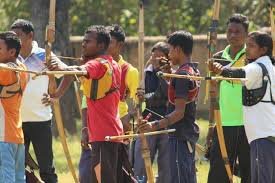
Deep within the dense, emerald-green forests of Chhattisgarh, far away from the buzz of media and the pressure of public scrutiny, a group of India’s finest archers is quietly preparing for what could be their most defining moment—the 2028 Olympics.
This is no ordinary training camp. There are no stadium lights, no cheering crowds, no news cameras. Instead, there are bamboo huts, chirping birds, arrows darting through humid air, and the order and discipline of an army. Welcome to India’s secret Olympic archery camp, where strategy meets survival and tradition collides with state-of-the-art performance science.
Why the secrecy?
The camp, which has been in hidden development for the last six months, is part of a covert operation by the Sports Authority of India (SAI) in partnership with the Indian Archery Federation (IAF) and military trainers. The aim? To toughen India’s archers—mentally and physically—by placing them in natural, challenging environments that mimic unpredictable real-world conditions.
“We didn’t want a five-star setup. We wanted our athletes to feel the rawness of pressure and unpredictability,” said a senior IAF official on condition of anonymity.”Olympic pressure is not only a matter of precision, it is also about nerves, focus, and flexibility. That is what these forests provide.”
Training amid trees and trials
Numerous factors contributed to the decision to train in this area, somewhere between the Bastar and Kanker districts. First, with thick sal and teak forests, different terrains, and essentially no digital life, the area provides both some isolation while immersing oneself in the area.
Each day begins at 4 a.m. Archers wake to the sound of tribal drums, a nod to the local culture that has deeply welcomed the team. After a short jog through misty trails, the real work begins:
- Target practice using moving targets attached to pulley ropes strung between trees
- Focus drills while balancing on narrow logs or under simulated “distraction zones” with sound
- Stealth movement and breathing techniques are adopted from traditional tribal hunting styles
- Yoga and meditation by a forest-side stream to improve mental clarity and control
“They are being trained to shoot after a sprint, in humidity, while standing on an unstable surface, or when it’s pouring,” explains a team coach. “These are the real-world conditions that test an archer’s edge.”
Technology in a Traditional Environment
The camp’s rustic setting is not as old-fashioned as it may appear. Sports scientists from Bengaluru visit once a month to consider muscle fatigue, eye-tracking, and posture using portable biomechanical devices. Drones occasionally hover above for shot analysis and trajectory breakdowns.
Surprisingly, the camp has also been aided by local tribal archers—particularly from the Gond and Muria communities—who use indigenous bows with stunning accuracy. In return, national archers have introduced compound bows and shared tips about international competition.
“It’s a beautiful cultural exchange,” says Reena Kumari, a Commonwealth Games medallist and now a mentor.“We can learn so much from these communities that have hunted and lived off the land for generations with archery.”
Handpicked and Hushed
There were only 12 archers (7 men and 5 women) handpicked for this intensive camp. Some names are recognizable, such as Arjun Verma and Isha Rawat, but there are also a few junior talents among the group. All had to sign NDAs (non-disclosure agreements) before entering the camp.
Communication with the outside world is restricted to one hour per week. Phones are sealed in a locker for most of the time. Family visits are prohibited, and updates to federations are channeled only through senior coaches.
“This isolation is not punishment—it’s preparation,” insists a psychologist associated with the camp. “To stand on an Olympic stage in front of the world, you need to train without needing validation from it.”
A Test Beyond the Bow
The Chhattisgarh forest camp is not just about shooting arrows—it’s about building warriors. In this setting, the archers confront their inner conflicts and distractions while also learning to follow the natural cadence to refine their craft.
With the 2028 Olympics still three years away, India appears to be playing the long game—the long game of combining ancient intuition with innovative thinking.
With the sun slipping behind the outline of the sal trees, young archer Ananya calmly collects her arrows, sweat pooling at her back, her eyes established somewhere deep in concentration. “This forest,” she tells me quietly, “teaches you to listen. To the wind, to the stillness, to yourself.”
FOR MORE UPDATES, VISIT SPACESPORTZ

More Stories
Historic Five-Wicket Victory Propels India to Women’s ODI World Cup Final
India Stuns Australia to Reach ODI World Cup Final with Record Chase
India Stuns Australia with Record Chase to Reach ODI World Cup Final